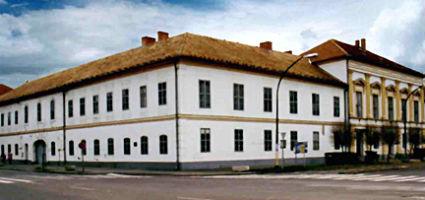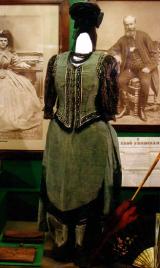2025. July 3. Thursday
Museum of the Hajdúság Region - Hajdúböszörmény
 |
Address: 4220, Hajdúböszörmény Kossuth Lajos utca 1.
Phone number: (52) 229-038, (52) 561-182
E-mail: info@hajdusagimuzeum.hu
Opening hours: Tue-Sun 10-16
|
At the end of the 19th century many museums were established in Hungary. The suggestion of Flóris Rómer marked the steps to be taken, and the offers of various collector groups hastened the procedure.
The Town Museum of Hajdúböszörmény was founded in 1924. Founder Péter H. Fekete had unperishable merits in the startin works. The main core of the material is made of by ethnografical, archeological and historical items. Authorities of the town were supporting the new institute and secured an annual budget, a director and permanen space for the operation of the museum. By today the museum has grown into an internationally acknowledged museum with a continuous and systemized operation.
The museum was given its new name (Hajdúság Museum) in 1951. The permanent exhibition was opened in the same year. The collection, which first consisted of ethnografical, archeological and historical items of Hajdúság, was later supplemented by the results of new researches, thus making up the permanent exhibition of the period between 18ó966 and 1985.
The third permanent exhibition of today represents the scientific works pursued by the professionals of the museum. The history and ethnography of Hajdúság are presented by a wide-range and significant material.
Besides the permamnent exhibition we have to mention the building of the museum, which is regarded as a first class monument by our institute.
As a result of the newest histirical researches we exactly know the functions of the chambers and corridors of the former headquarters of Hajdú region. The most valueable part of the building is now used for as an exhibition space for the ethnografical, archeological, arts and historical exhibition of the museum, whereas the other wing at the Bocskai Square gives home to the legal court. An entire museological renovation accomplished recently has replaced the headquarters into the forn of its old pomp.
According to its actual function and the financial abilities, the building was built and extended in three different phases.
The first part was designed and accomplished by mason János Jenovai between 1762 and 1765. Under this wing of the building there was a dungeon consisting of four cells, but because of statical reasons this cellar has been filled up. Bandi Angyal, a prisoner known from popular ballads, had also been kept here.
Extention works were done on the building in 1803. A contract was drawn with architect József Rachbauer from Debrecen. During the building works Rachbauer got ill and the finishing touches were made by András Jarabin from Eger. The wing was inaugurated in August 1808.
The third phase of the building works meant the accomplishment of the court and a new prison. Sketches were drawn by engeneer János Balthazár, and the accomplishment was done by architect Imre Vecsey. The extention and the new wing was handed over in 1871.
After the ceassion of the headquarters (1876) the house had a large number of functions. It operated as a bank, a press, fireworks, youth hostel, etc. Today the building is serves as a worthy home for the museum.
Imre Varjasi
The Town Museum of Hajdúböszörmény was founded in 1924. Founder Péter H. Fekete had unperishable merits in the startin works. The main core of the material is made of by ethnografical, archeological and historical items. Authorities of the town were supporting the new institute and secured an annual budget, a director and permanen space for the operation of the museum. By today the museum has grown into an internationally acknowledged museum with a continuous and systemized operation.
The museum was given its new name (Hajdúság Museum) in 1951. The permanent exhibition was opened in the same year. The collection, which first consisted of ethnografical, archeological and historical items of Hajdúság, was later supplemented by the results of new researches, thus making up the permanent exhibition of the period between 18ó966 and 1985.
The third permanent exhibition of today represents the scientific works pursued by the professionals of the museum. The history and ethnography of Hajdúság are presented by a wide-range and significant material.
Besides the permamnent exhibition we have to mention the building of the museum, which is regarded as a first class monument by our institute.
As a result of the newest histirical researches we exactly know the functions of the chambers and corridors of the former headquarters of Hajdú region. The most valueable part of the building is now used for as an exhibition space for the ethnografical, archeological, arts and historical exhibition of the museum, whereas the other wing at the Bocskai Square gives home to the legal court. An entire museological renovation accomplished recently has replaced the headquarters into the forn of its old pomp.
According to its actual function and the financial abilities, the building was built and extended in three different phases.
The first part was designed and accomplished by mason János Jenovai between 1762 and 1765. Under this wing of the building there was a dungeon consisting of four cells, but because of statical reasons this cellar has been filled up. Bandi Angyal, a prisoner known from popular ballads, had also been kept here.
Extention works were done on the building in 1803. A contract was drawn with architect József Rachbauer from Debrecen. During the building works Rachbauer got ill and the finishing touches were made by András Jarabin from Eger. The wing was inaugurated in August 1808.
The third phase of the building works meant the accomplishment of the court and a new prison. Sketches were drawn by engeneer János Balthazár, and the accomplishment was done by architect Imre Vecsey. The extention and the new wing was handed over in 1871.
After the ceassion of the headquarters (1876) the house had a large number of functions. It operated as a bank, a press, fireworks, youth hostel, etc. Today the building is serves as a worthy home for the museum.
Imre Varjasi
|
Programmes
|
|
